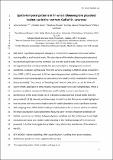Files in this item
Spatio-temporal patterns in fin whale (Balaenoptera physalus) habitat use in the northern Gulf of St. Lawrence
Item metadata
| dc.contributor.author | Schleimer, Anna Colette Helene | |
| dc.contributor.author | Ramp, Christian | |
| dc.contributor.author | Plourde, Stéphane | |
| dc.contributor.author | Lehoux, Caroline | |
| dc.contributor.author | Sears, Richard | |
| dc.contributor.author | Hammond, Philip Steven | |
| dc.date.accessioned | 2020-07-29T23:41:19Z | |
| dc.date.available | 2020-07-29T23:41:19Z | |
| dc.date.issued | 2019-07-30 | |
| dc.identifier | 259223368 | |
| dc.identifier | b0a8dd9b-0ea4-41c3-8538-14e8fb1ac426 | |
| dc.identifier | 85069934006 | |
| dc.identifier | 000485736900016 | |
| dc.identifier.citation | Schleimer , A C H , Ramp , C , Plourde , S , Lehoux , C , Sears , R & Hammond , P S 2019 , ' Spatio-temporal patterns in fin whale ( Balaenoptera physalus ) habitat use in the northern Gulf of St. Lawrence ' , Marine Ecology Progress Series , vol. 623 , pp. 221-234 . https://doi.org/10.3354/meps13020 | en |
| dc.identifier.issn | 0171-8630 | |
| dc.identifier.other | ORCID: /0000-0002-2381-8302/work/60195438 | |
| dc.identifier.other | ORCID: /0000-0002-9798-5074/work/60428021 | |
| dc.identifier.uri | https://hdl.handle.net/10023/20369 | |
| dc.description | A. Schleimer was supported by the Luxembourg National Research Fund (FNR; AFR/11256673). | en |
| dc.description.abstract | Significant ecosystem changes in the Gulf of St. Lawrence (GSL) have had far-reaching effects at all trophic levels. The abundance of fin whales (Balaenoptera physalus) has declined significantly in the northern GSL over the past decade. This study aimed to test the hypothesis that the observed decline was correlated to changing environmental conditions. Cetacean sighting data from 292 surveys, resulting in 2986 fin whale encounters from 2007 to 2013, were used to fit two separate generalised additive models in terms of (1) bathymetric and oceanographic variables (the proxy model) and (2) modelled krill biomass (the prey model). The concept of “handling time” was introduced to correct for time off search effort, applicable to other studies relying on opportunistically sampled data. While a positive correlation between krill biomass and fin whale numbers was found, the performance of the proxy model (24.2 % deviance explained) was overall better than the prey model (11.8 %). Annual predictive maps derived from the final proxy model highlighted two key areas with recurrently high relative fin whale abundance and a significant overlap with shipping lanes. While both models provided evidence for an annual decline in relative fin whale abundance, static bathymetric features were the most important predictors of habitat use and no correlation between dynamic variables and the decline was found. High resolution prey data and a better understanding of the feeding ecology of fin whales are proposed to further investigate the predator-prey relationship and decline of fin whales in the GSL. | |
| dc.format.extent | 2982466 | |
| dc.language.iso | eng | |
| dc.relation.ispartof | Marine Ecology Progress Series | en |
| dc.subject | Habitat modelling | en |
| dc.subject | Effort quantification | en |
| dc.subject | Handling time | en |
| dc.subject | Proxy variables | en |
| dc.subject | Distribution | en |
| dc.subject | Predictive maps | en |
| dc.subject | Opportunistic surveys | en |
| dc.subject | GC Oceanography | en |
| dc.subject | QH301 Biology | en |
| dc.subject | NDAS | en |
| dc.subject.lcc | GC | en |
| dc.subject.lcc | QH301 | en |
| dc.title | Spatio-temporal patterns in fin whale (Balaenoptera physalus) habitat use in the northern Gulf of St. Lawrence | en |
| dc.type | Journal article | en |
| dc.contributor.institution | University of St Andrews. School of Biology | en |
| dc.contributor.institution | University of St Andrews. Sea Mammal Research Unit | en |
| dc.contributor.institution | University of St Andrews. Marine Alliance for Science & Technology Scotland | en |
| dc.contributor.institution | University of St Andrews. Scottish Oceans Institute | en |
| dc.contributor.institution | University of St Andrews. Centre for Research into Ecological & Environmental Modelling | en |
| dc.identifier.doi | 10.3354/meps13020 | |
| dc.description.status | Peer reviewed | en |
| dc.date.embargoedUntil | 2020-07-30 |
This item appears in the following Collection(s)
Items in the St Andrews Research Repository are protected by copyright, with all rights reserved, unless otherwise indicated.

